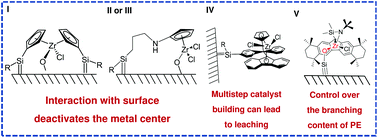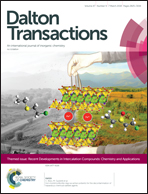Tailoring 2D and 3D molecular sieves structures for polyolefin composites: do all roads lead to remarkable performances?†
Abstract
Multiple synthetic strategies were performed in order to tether a zirconium-based catalyst to the 2D and 3D molecular sieves for olefin polymerizations. The anchoring of fluorene silane to the mesoporous MCM-41 was performed in order to obtain a stable catalyst for olefin polymerization (1@MCM-41). Using spectroscopic methods, this system was shown to have the metal center locked on a face down conformation with the surface. Also, immobilized zirconium complexes have been prepared on three different types of aminopropyl-modified supports (2@magadiite, 2@MCM-41 and 3@MCM-48). The advantage of this latter method of immobilization would be the reduction of the steric effect caused by the support: the catalyst, distant from the surface, is more exposed to the monomer and this situation may lead to an increase in the catalytic activity compared to 1@MCM-41. However, a medium size chain as a spacer between the support and the metallocene is still flexible enough to bend and predisposes the metal center to interact with the support surface; this effect is more evident when the nature of the support is of fixed pore dimensions. These supported catalysts exhibited activity for ethylene polymerization, resulting in linear PEs with high melting temperatures. In order to retain a metallocene assembled as in a homogeneous environment, a multi-step reaction was investigated (4@magadiite) but it led to the leaching of the organic moieties from the surface during catalyst preparation. The best catalytic performance was achieved when homogeneous Oct-amido catalyst (5) was reacted with the surface of magadiite and n-alkyl-AlPO-kan.

- This article is part of the themed collection: Recent Developments in Intercalation Compounds: Chemistry and Applications


 Please wait while we load your content...
Please wait while we load your content...